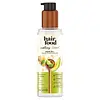What's inside
What's inside
 Key Ingredients
Key Ingredients

No key ingredients
 Benefits
Benefits

 Concerns
Concerns

 Ingredients Side-by-side
Ingredients Side-by-side

Water
Skin ConditioningSodium Lauryl Sulfate
CleansingSodium Laureth Sulfate
CleansingCocamidopropyl Betaine
CleansingGlycol Distearate
EmollientSodium Citrate
BufferingCocamide Mea
EmulsifyingSodium Xylenesulfonate
Parfum
MaskingCitric Acid
BufferingSodium Benzoate
MaskingSodium Chloride
MaskingGuar Hydroxypropyltrimonium Chloride
Skin ConditioningGlycerin
HumectantTetrasodium EDTA
Limonene
PerfumingMagnesium Nitrate
Aloe Barbadensis Leaf Juice
Skin ConditioningMacadamia Ternifolia Seed Oil
EmollientCI 19140
Cosmetic ColorantMethylchloroisothiazolinone
PreservativeMagnesium Chloride
CI 17200
Cosmetic ColorantMethylisothiazolinone
PreservativeAscorbic Acid
AntioxidantSodium Sulfite
PreservativePotassium Sorbate
PreservativeWater, Sodium Lauryl Sulfate, Sodium Laureth Sulfate, Cocamidopropyl Betaine, Glycol Distearate, Sodium Citrate, Cocamide Mea, Sodium Xylenesulfonate, Parfum, Citric Acid, Sodium Benzoate, Sodium Chloride, Guar Hydroxypropyltrimonium Chloride, Glycerin, Tetrasodium EDTA, Limonene, Magnesium Nitrate, Aloe Barbadensis Leaf Juice, Macadamia Ternifolia Seed Oil, CI 19140, Methylchloroisothiazolinone, Magnesium Chloride, CI 17200, Methylisothiazolinone, Ascorbic Acid, Sodium Sulfite, Potassium Sorbate
 Reviews
Reviews

Ingredients Explained
These ingredients are found in both products.
Ingredients higher up in an ingredient list are typically present in a larger amount.
Parfum is a catch-all term for an ingredient or more that is used to give a scent to products.
Also called "fragrance", this ingredient can be a blend of hundreds of chemicals or plant oils. This means every product with "fragrance" or "parfum" in the ingredients list is a different mixture.
For instance, Habanolide is a proprietary trade name for a specific aroma chemical. When used as a fragrance ingredient in cosmetics, most aroma chemicals fall under the broad labeling category of “FRAGRANCE” or “PARFUM” according to EU and US regulations.
The term 'parfum' or 'fragrance' is not regulated in many countries. In many cases, it is up to the brand to define this term.
For instance, many brands choose to label themselves as "fragrance-free" because they are not using synthetic fragrances. However, their products may still contain ingredients such as essential oils that are considered a fragrance by INCI standards.
One example is Calendula flower extract. Calendula is an essential oil that still imparts a scent or 'fragrance'.
Depending on the blend, the ingredients in the mixture can cause allergies and sensitivities on the skin. Some ingredients that are known EU allergens include linalool and citronellol.
Parfum can also be used to mask or cover an unpleasant scent.
The bottom line is: not all fragrances/parfum/ingredients are created equally. If you are worried about fragrances, we recommend taking a closer look at an ingredient. And of course, we always recommend speaking with a professional.
Learn more about Parfum